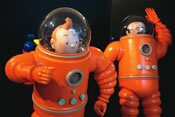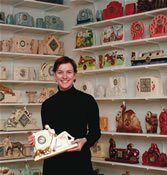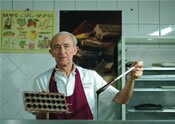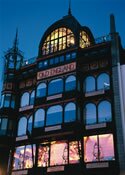Inflight Magazine of Brussels Airlines
Welcome to the Inflight Magazine of Brussels Airlines
The weird and the wonderful
As well as the cultural big-hitters, Brussels boasts a wide selection of far less orthodox museums, as Guy Dittrich discovers
 As you would expect of all proper capital cities, Brussels has the usual run of museums covering the standards such as ancient and modern arts, natural and military history and so on. A good concentration of these can be found on the Mont des Arts, a steep street that links the upper and lower parts of the city, and at an ‘annex’ in Cinqauntenaire Park to the east of the city centre. These tourist haunts are found in all the guidebooks. What the guidebooks don’t tell you, however, is about the plethora of quirky and downright crazy museums the capital has to offer, which is where we come in.
As you would expect of all proper capital cities, Brussels has the usual run of museums covering the standards such as ancient and modern arts, natural and military history and so on. A good concentration of these can be found on the Mont des Arts, a steep street that links the upper and lower parts of the city, and at an ‘annex’ in Cinqauntenaire Park to the east of the city centre. These tourist haunts are found in all the guidebooks. What the guidebooks don’t tell you, however, is about the plethora of quirky and downright crazy museums the capital has to offer, which is where we come in.
With museums dedicated to plastic (the Plasticarium) and Freemasonry, Chinese missionaries and Jewish-Moroccan Art, it is clear that the Belgians are a people who have collecting in their psyche. In a country that some see as the home of surrealism, led by the likes of Magritte (a new museum of his works and life is due to open in Spring 2009 within the Museum of Fine Arts; in the meantime visit the René Magritte Museum set in one of his homes and now a shrine to the artist), eyebrows are hardly raised at the mention of museums devoted to faience (ceramic) clocks (the Clockarium), not only ‘Spontaneous art’ but also ‘Fantastic art’, to the American civil war (the Confederate Museum) and to sewers. Sadly, the Museum de Slips (underpants – no kidding) recently closed and you can’t get much more surreal than that.
Whilst in the home of Tin Tin, Lucky Luke and the Smurfs, it is no surprise to find a museum devoted to the ninth art, the Belgian Centre for Comic Strip Art. Belgium’s grand beer-making heritage, meanwhile, is celebrated with no fewer than three museums. We have yet to find a museum devoted to another Belgian classic, the frite, but we have found a chocolate museum.
Of course, such specialism comes at a price. Not so much in terms of entrance fees; these places are often run by passionate obsessives who are doing it for love, not money. More of a problem are the often restricted opening hours or visits ‘by appointment only’. Additionally, presentation standards in these specialist museums can be rather lacklustre and this could be a disappointment, especially as some can be a trek to get to.
We take you on a tour of some of the more centrally located museums that are worthy of a quick browse or an indulgent couple of hours.
Museum of Manneken-Pis
 A newly opened section of the Brussels City Museum, a medieval survivor right on the Grand Place, this permanent specialist exhibition concentrates on the history and costumes of Brussels’ favourite son, the Manneken-Pis. Discover the history of the little boy’s origins and admire his vast collection of costumes donated by countries and associations from around the globe. A video loop at the entrance provides an entertaining ‘hidden camera’ look at the reactions to the diminutive statue of various nationalities and age groups over the decades.
A newly opened section of the Brussels City Museum, a medieval survivor right on the Grand Place, this permanent specialist exhibition concentrates on the history and costumes of Brussels’ favourite son, the Manneken-Pis. Discover the history of the little boy’s origins and admire his vast collection of costumes donated by countries and associations from around the globe. A video loop at the entrance provides an entertaining ‘hidden camera’ look at the reactions to the diminutive statue of various nationalities and age groups over the decades.
The costumes – there is only a space to show a rotating selection of his much larger collection – range from various military regalia (a Brabant Patriot or French Empire Marshall), public service workers (fire fighter, public sanitation worker or airline pilot) to national costumes. One day he may be sporting a Peruvian poncho, the next an Astrakan hat from Azerbeidjan. An interactive multi-media station allows visitors to search for details of their favourite costume. Elvis Presley, anyone?
Allegedly, the exhibition is home to the original Manneken-Pis; to see what his double is wearing today, take a quick stroll around the corner.
Museum of Chalcographie
Chalcographie is the art of printing by engraving and not a lot of people know that. This super-quirky venue is more gallery than museum, with only a small wall display explaining the less than complicated production process – that same one that is used by the curators today to run off prints for sale, reasonably priced from €17 (black and white) and €25 (colour), more if signed by the artist. The word is derived from the Greek khalkos (copper) and graphos (writing), and the collection includes over 6,000 ancient and modern engraved plates in copper and wood. Browse the large binders packed with scenes typical of Belgium, its history and landscape. The artwork ranges from antique to contemporary abstracts. The museum is not easy to find, though. At Place du Musée look to the right for the arc of three doors. Ring the buzzer and enter the grand cupola lobby and then walk down several flights of stairs. Finally, opening out on to a green square, the journey emphasises the steep embankment that splits the upper and lower parts of the city.
Museum of Street Lamps (Le Musée de Réverbére)
It’s certainly unusual and whilst pushing the boundaries of what comprises a museum, the Musée de Réverbére definitely offers free entry and has no opening (or closing) hours. Running along Rue Emile Delva, between the Sacre Coeur basilica and the Royal gardens, is a parade of 15 street lamps that shows the chronological development of street lighting. In its heyday of the 1830s, Brussels was the first European city to operate an urban lighting system. Each lamp has a plaque that helps track the change from gas-powered to electric street lighting and the stylistic changes of an everyday object so often taken for granted. Aim to visit around sunset. This particular historical examination is appropriate for a city that does well in the lighting department – check out the free, nightly neon washes flashing across the Dexia building on Place Rogier, the pinpricks of light emanating from the cobblestones surrounding the statue to Queen Elisabeth of Belgium on Place de l’Albertine or the drooping, yellow globes at Square de l’Aviation.
Museum of Cocoa and Chocolate
 Ever wondered what a cocoa pod looks like, its growth cycle or the true nutritional benefits of chocolate? A quick turn around the two floors of this boutique museum will reveal all. Starting off with a spéculoos (a spicy and buttery biscuit, another Belgian speciality) dipped in warm chocolate couldn’t be more appropriate before watching chocolate bars being prepared in front of you. Head upstairs to see the Sao Tomé dugout canoe formerly used to transport the beans and more detail on Venezuelan cocoa production. To purchase the best of the city’s produce, make for the somewhat more glamorous surroundings of Pierre Marcolini (Place du Grand Sablon 39, tel. ), Wittamer (Place du Grand Sablon 6, tel.
Ever wondered what a cocoa pod looks like, its growth cycle or the true nutritional benefits of chocolate? A quick turn around the two floors of this boutique museum will reveal all. Starting off with a spéculoos (a spicy and buttery biscuit, another Belgian speciality) dipped in warm chocolate couldn’t be more appropriate before watching chocolate bars being prepared in front of you. Head upstairs to see the Sao Tomé dugout canoe formerly used to transport the beans and more detail on Venezuelan cocoa production. To purchase the best of the city’s produce, make for the somewhat more glamorous surroundings of Pierre Marcolini (Place du Grand Sablon 39, tel. ), Wittamer (Place du Grand Sablon 6, tel.
) or Frederic Blondeel (Baksteenkaai 24, tel. ).
Musical Instruments Museum (MIM)
Sounding rather mainstream, the MIM delves deep into its archive of over 7,000 musical instruments to display over 1,500 at any one time and deliver a wealth of narrative to those interested in this field. Admire the beauty of the inlays on harpsichords and pianos that once graced the courts of Europe. But more pertinently, the infrared headphone system allows guests to hear the tunes and sounds of the instruments on display. For more insight into a particular genre, grab a headset for a self-guided thematic tour. There is also an active kids’ programme. The museum is housed in one of the finest art nouveau buildings around. The luxuriously appointed Old England department store offers great views of the city from its rooftop restaurant and terrace.
 Museum of Costume & Lace
Museum of Costume & Lace
The fame Belgium gained from its 18th-century lace-making heritage is celebrated in this museum, just off the Grand Place. We recommend a visit here to see the ‘From New Look to Expo 58’ exhibition that runs until the end of 2008. The exhibition surveys fashions from the 50s and ties in with the 50th anniversary of the 1958 Brussels Expo, of which the sparkling Atomium is the centrepiece.
Elegant creations in frothy pink chiffon and tight silhouettes from the likes of Dior are the order of the day here, reflective of the Brussels bourgeoisie as they began to splash out after the deprivations of the war period.
Contact details
Plasticarium 35 Rue Locquenghein, tel.
, on request, groups only, €8
Museum of Freemasonry 79 Rue de Laeken, tel. , Thurs only, 2pm-5pm, €2
Museum of China 548 Chaussee de Ninove, tel , scheut.be, MonFri 2.30-5.30 by appt only, free
Museum of Jewish-Moroccan Art 19 Place J Vnader Elst, tel. , judaisme-marocain.org, 25 Apr – 30 Jun & 1 Sept – 22 Dec, daily 11am-5pm, closed Sat
René Magritte Museum 135 Rue Esseghem, tel. , daily 10am-6pm, €7, magrittemuseum.be
Belgian Centre for Comic Strip Art 20 Rue des Sables, tel. , comics-center.net, Tues-Sun 10am-6pm, €7.50
Clockarium Museum 163 Boulevard A Reyers, tel. , clockarium. com, guided tours (min 10 people) Sun only at 3pm, on request, €6
Museum of Spontaneous Art 27 Rue de la Constitution, tel. , TuesSat 1pm-5pm, €2
Museum of Fantastic Art 7 Rue Américaine, tel. , Sat-Sun May-Sept, €6
Confederate Museum 40 Rue de al Charrette, tel. , by appt, free
Sewers Museum Porte d’Anderlecht, tel.
, brucity.be, Tues-Fri 10am-5pm, Sat-Sun 2pm-5pm, €3
Schaerbeek Museum of Beer 33/35 Avenue L Betrand, tel. , Wed & Sat 2pm-6pm, €3 (includes tasting)
Museum of Manneken-Pis at the City Museum Grand Place, tel. , brucity.be, Tues-Sun 10am-5pm, €3
Museum of Chalcographie 2 Place du Musée, tel. , Mon-Fri 9am-1pm & 2pm-4.45pm, free
Museum of Street Lamps 75-87 Rue Delva, open 24 hrs, free
Museum of Cocoa and Chocolate 9-11 Rue de la Tete D’Or, tel. , mucc.be, Tues-Sun 10am-4.30pm, €5
Musical Instruments Museum (MIM) 2 Montagne de la Cour, tel. , musicalinstrumentsmuseum.be, Tues-Fri
9.30-4.45pm, Sat-Sun 10am-4.45pm, €5
Museum of Costume and Lace 4-12 Rue de la Violette, tel. , Mon-Fri 10am-5pm, closed Wed, Sat-Sun 2pm-5pm, €3
Leave a Reply
